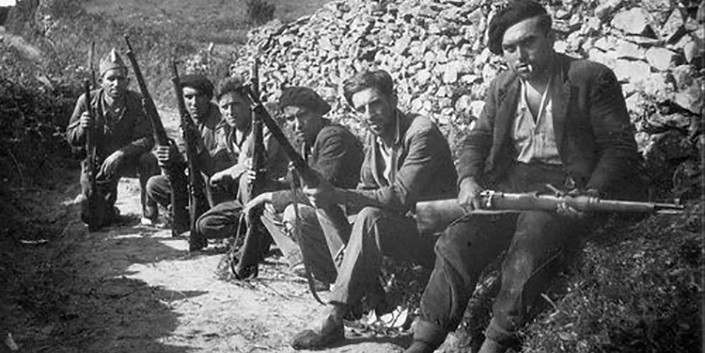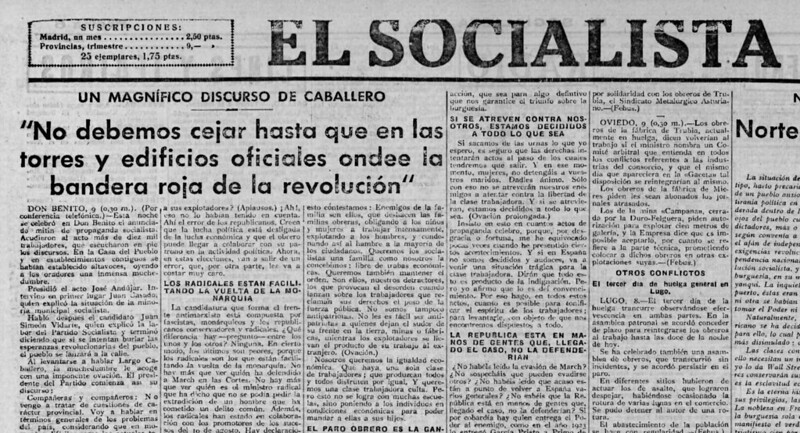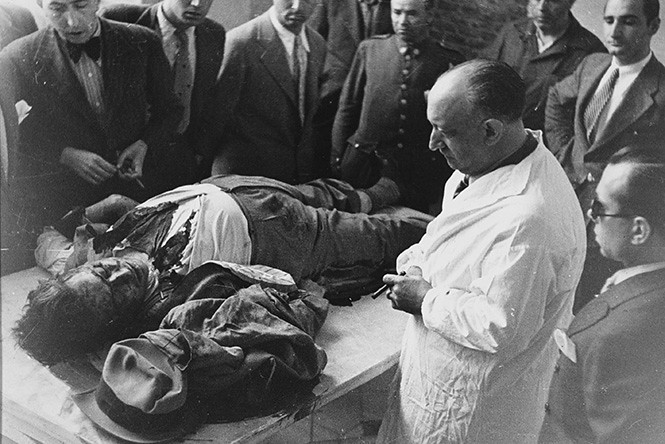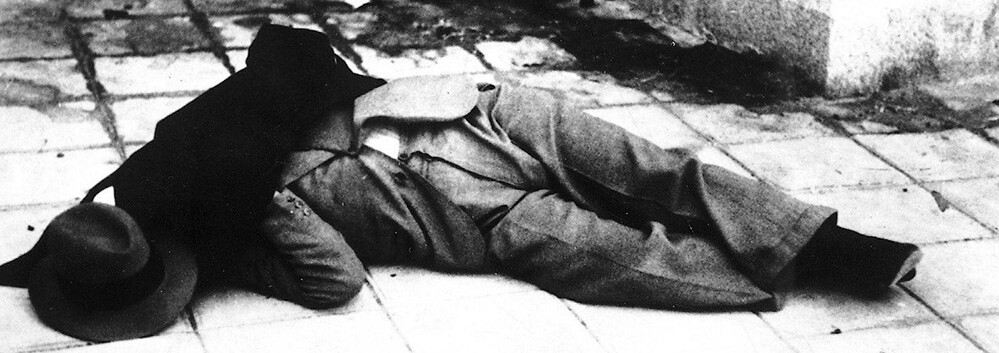José Calvo Sotelo: this was the socialist crime that caused the start of the Spanish Civil War
The PSOE had already warned: "the revolution is not made with shouts of long live Socialism, long live communism and long live anarchism. It is done violently".
The violent harangues of the PSOE during the Spanish Second Republic
Those words were pronounced by Francisco Largo Caballero, then president of the PSOE (Spanish Socialist Workers' Party, the majority party of the Spanish left), on April 20, 1934 in an incendiary speech at the V Ordinary Congress of the Federation of Socialist Youth, held in the party hall of the Madrid Metropolitan. It was not a hidden or discreet statement: it was published openly by the official PSOE newspaper, "El Socialista", on the cover of its number 7,867 on April 21, 1934 (see PDF).

At that congress, Largo Caballero also told the young socialists: "I maintain the view that political power must be seized revolutionaryly." The PSOE was then in opposition, after the electoral victory of the center-right in the November 1933 elections. This incitement to violence was not new. In public acts and in statements published by "El Socialista", Largo Caballero had proposed replacing the Second Republic with a socialist dictatorship and had even threatened with a civil war. Those totalitarian harangues soon began to lead to the assassination of political rivals at the hands of PSOE gunmen.
'La Motorizada': an armed group of the PSOE implicated in several murders
Several members of an armed group of the PSOE, known as "La Motorizada" (The Motorized), who was escorting socialist leaders like Indalecio Prieto. The name of that group was due to the fact that they rode on motorcycles, including some American Harley-Davidsons, a luxury for Spain at the time. Violence was something so common in the ranks of the PSOE that they even staged shootouts between different sectors of the party.

One of the most prominent members of this PSOE armed group was José del Castillo Sáenz de Tejada, a lieutenant in the Assault Guard, a police force with many agents on the left, and a military instructor for "La Motorizada". On April 14, 1934, he and his men shot up a funeral procession that was carrying the remains of a civil guard killed by the left. As a result of their shots, the Falangist Andrés Sáenz de Heredia and the Carlist José Luis Llaguno Acha were assassinated. Some pointed out that Lieutenant Castillo himself was responsible for the shots that caused these deaths. In revenge for that, some gunmen assassinated Castillo on July 12, 1936 (some sources point to Falangists and others to Carlists).
The wave of violence unleashed by the left after its arrival in power
The situation in Spain was very violent for years before. Carrying out a href="https://www.outono.net/elentir/2020/10/11/largo-caballero-las-frases-antidemocraticas-del-lider-extremista-al-que-reivindica-el-psoe/">Largo Caballero's threats to provoke a "civil war", the PSOE had led a bloody coup d'état in October 1934, which had its epicenter in Asturias and in which the socialists and their allies assassinated 33 priests and religious and 300 military and members of the security forces, in addition to destroying 17 churches, 40 religious buildings and dozens of factories, bridges, houses and public buildings. In February 1936, the left won the elections with the help of a electoral fraud, and one of the first things he did was pardon the coupists and get them out of jail.

That brazen amnesty against those responsible for a coup was a call to violence. And that is what happened. On June 16, 1936, José María Gil Robles, head of the majority opposition party (CEDA), exposed in the Cortes the acts of violence committed by the left in the previous months: "from February 16 to 15 Last June, a numerical summary shows the following data: churches totally destroyed, 160; temple assaults, fire suppression, destruction and attempted assault, 251; dead, 269; wounded of different severity, 1,287; frustrated personal aggression or whose consequences are not recorded, 215; completed robberies, 138; robbery attempts, 23; destroyed political and private centers, 69; idem assaulted, 312; general strikes, 113; partial strikes, 228; totally destroyed newspapers, 10; assaults on newspapers and attempted assaults and destruction, 33; bombs and firecrackers that explode, 146; collected unexploded, 78."
The death threats of the left against Calvo Sotelo in the Cortes
That same day, and after that intervention by Gil Robles, deputy José Calvo Sotelo, leader of the right-wing Spanish Renovation party, took the floor, pointing out the government's responsibility in the face of these disorders exposed by the CEDA leader. Calvo Sotelo, who was possibly already threatened with death, stood up to the left: "I say what Santo Domingo de Silos replied to a Castilian king: ‘Lord, you can take my life but you cannot do more. And it is preferable to die with glory than to live with vilification.'"

To give us an idea of the level of bullying on the left at that time, in that same parliamentary session, the communist deputy Dolores Ibárruri, "La Pasionaria", sentenced Calvo Sotelo: "This man has spoken for the last time." It was not the last public threat received by the leader of Renovación Española. On July 1, also in Parliament, the socialist deputy Ángel Galarza told José Calvo Sotelo: "Thinking of your lordship, I find everything justified, including the attack that deprived him of his life." Significantly, in 1931 Galarza had been the creator of the Assault Guard, the police force of which Lieutenant Castillo was a member.
The kidnapping of Calvo Sotelo by the Assault Guard and 'La Motorizada'
The murder of Castillo, revenge for a crime committed by him and his men, gave way to a new revenge by a group of assault guards and members of "La Motorizada". On the night of July 12 to 13, they went in an Assault Guard van, number 17, to the home of the leader of Renovación Española Antonio Goicoechea and, later, to that of the leader of the CEDA, Gil Robles. The purpose of these visits was to kidnap and kill them in revenge for Castillo's death, but neither of them were home at the time. So that group of assault guards and thugs of the PSOE went to José Calvo Sotelo's home.

They arrived there at three in the morning. Calvo Sotelo was told that he was being detained at the General Directorate of Security. The deputy was outraged and replied: "Detained? But why? And my parliamentary immunity? And the inviolability of the home? I am a Deputy and the Constitution protects me!" To reassure Calvo Sotelo, a member of the group of socialist thugs identified himself as a member of the Civil Guard, a corps that the deputy had defended in Parliament. Calvo Sotelo said goodbye to his family and promised to call as soon as he could, "unless these gentlemen take me away to shoot me four times." Witnesses point out that the deputy went down to the street calmly, wearing a gray suit and a hat of the same color. They sat him on the third bench of the truck.
The murder of the deputy with a shot to the neck
Truck number 17 then headed towards the General Directorate of Security. Along the way, his captors pulled his American jacket back to immobilize Calvo Sotelo so that he could not defend himself. Finally, a socialist who was sitting on the fourth bench of the van, Luis Cuenca Estevas, a member of the PSOE youth and "La Motorizada", fired a shot in the neck of the deputy, with exit through the left eye and loss of brain mass, according to the forensic doctors, doctors Piga and Águila, in the autopsy carried out on the morning of the day 14th.

The lifeless body of Calvo Sotelo was abandoned at 4:00 in the morning of July 13 in the deposit of the Cemetery of the East, in Madrid. The assault guards told the cemetery guards that the deceased was a night watchman and that he had been killed in an attack, and that later they would send the documentation of the deceased. Verifying that the dead man had no documentation on him, the guards called the Duty Judge, who did not go to the cemetery until noon on July 13, when the news of the murder was already circulating throughout the city of Madrid.
The inaction of the government against the perpetrators of this State crime
That murder was a very serious event. Calvo Sotelo was one of the leaders of the parliamentary opposition, and some of the perpetrators of the crime were police officers at the service of a left-wing government, a government of the Popular Front (of which the PSOE was a part) headed by Santiago Casares Quiroga, a member of Izquierda Republicana (Republican Left) party. The assassin himself, Luis Cuenca, told the editor of "El Socialista" (the PSOE newspaper), Julián Zugazagoitia, what they had done, and he said: "That attack is war."

The burial of José Calvo Sotelo took place on July 14, 1936 at four in the afternoon. A crowd attended the funeral. In the following hours, the government ordered the arrest of dozens of right-wing people, but not the perpetrators of the crime, who went unpunished. As if the situation was not already abnormal enough, a decree by the President of the Republic suspended parliamentary sessions for 8 days. On July 15, the Permanent Council of the Cortes met to debate the fifth extension of one of the 23 States of Alarm that were declared in the first five years of the Second Republic, a decision that allowed the government to impose censorship on the press.
Calvo Sotelo's bodyguards received orders to abandon him
At that meeting of the permanent deputation, Gil Robles stated:
"Last Wednesday, honorable deputies –exactly eight days ago today–, Mr. Calvo Sotelo called me aside, in one of the corridors of the Chamber, and told me: «Individuals of my escort, who certainly do not belong to the Police, but to one of the Armed Corps, have received an instruction that in the event of an attack against my person they try to refrain. What do you suggest for me?""

Gil Robles had advised him to speak immediately with the Minister of the Interior. The CEDA leader added: "Mr. Calvo Sotelo went to tell it, on Wednesday or Thursday, to the Minister of the Interior, who, according to my news received by Mr. Calvo Sotelo, said that nothing had emanated from him at all. no order of that nature. But Mr. Calvo Sotelo had a very exact confidence." Gil Robles also recalled what he had said to deputy Juan Ventosa Calvell, of the Catalan Regionalist League, before the assassination of the leader of Renovación Española:
"An attack is being prepared against Mr. Calvo Sotelo. There have been part of organisms dependent on the Ministry of the Interior, never from the Minister of the Interior, orders so that the attack that is being prepared goes unpunished. You know it; You and I are witnesses that this warning has been sent to the Government, that this threat is hanging over Mr. Sotelo's head."
That crime was the trigger for the Spanish Civil War
Thus, the kidnapping and murder of Calvo Sotelo was not the work of some uncontrolled: his own escort had received orders to leave him helpless, and the government, which was warned of the danger that the right-wing deputy was running, did nothing to protect him. Given the magnitude of this state crime and the government's scandalous reaction, many Spaniards who still had doubts ended up losing faith in the Republic. That state crime was the icing on the cake of a situation that had already been unsustainable for months, a situation that the left had tensed to the extreme with its wave of violence. On July 17, the Spanish Civil War began with the military uprising in North Africa, which would spread to a large part of the Peninsula the following day.
The disorders provoked by the left and the assassination of Calvo Sotelo ended up convincing many that Spain was no longer a democracy, and that the left was preparing to carry out that violent revolution that Largo Caballero had publicly announced. That was the cause of the beginning of the Spanish Civil War, which today some -among them the PSOE- try to rewrite as a confrontation between fascists and democrats, to hide its dark past. As if the assassination of an opposition leader by agents under government orders was something own of a democratic country.
|
Don't miss the news and content that interest you. Receive the free daily newsletter in your email: Click here to subscribe |
- Most read
- The 'hole' without civil flights around Paris during the opening of the Olympic Games
- Spain vetoes the Russian frigate 'Shtandart', which intended to reach Vigo, in all its ports
- The interior of the Statue of Liberty torch and the sabotage that canceled its visits
- The ten oldest national flags in the world that are still in use today
- The BNG boasts of the support of a terrorist group and a dictatorship at a public event
- The Russian intelligence document that sparked a hoax about French troops
- A virtual tour of ancient Rome in full color, just as it was in its heyday

 ES
ES





Opina sobre esta entrada: